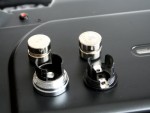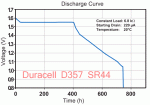The TL120 is a “traditional” camera if, by “traditional”, you mean something from the 1980’s or 1990’s. It shots on film, has a flash hot shoe, a reflective exposure meter, and uses an electro-mechanical shutter. The power supply is also from that same tradition, a pair of button-cell batteries.
Power Source
The camera is designed to use two SR44 cells which is a slightly odd choice. Given that the camera is already more than 2kg, why not provide the option of a larger capacity battery bank? I suspect it was just assumed that this new camera should be fed like any other camera, and the designer defaulted to button cells. The downsides of this choice are:
is designed to use two SR44 cells which is a slightly odd choice. Given that the camera is already more than 2kg, why not provide the option of a larger capacity battery bank? I suspect it was just assumed that this new camera should be fed like any other camera, and the designer defaulted to button cells. The downsides of this choice are:
- Low power capacity
- High replacement cost
The silver-oxide SR44 cells typically have a power capacity between 150 and 170mAh, and cost about $2 each. A similar battery, the alkaline LR44 carries between 100 and 150 mAh and commonly costs about $1 each. A very different, but interesting alternative, the zinc-air PR44 carries 600mAh and costs about $1 each.
Current Requirements
The battery supplies power to the camera meter and shutter. The meter will draw power while the button under the left thumb is pressed, or when the shutter is cocked and the shutter button is half-pressed. The shutter draws power as long as it is open. A long exposure requires a lot of battery capacity.
The meter draws .010 amps (10ma). The shutter draws .023 amps (23ma). If both the shutter and meter are active, the draw is .032 amps (32ma). In normal operation, the meter is not drawing power while the shutter is open. This scenario was contrived only for demonstration purposes.
Without an operational battery, the camera meter will not work and the shutter will only work at its fastest rate (1/500th of a second).
Voltage Requirements
Batteries are not a constant-voltage power supply. Their voltage will vary with age, use, temperature, and load. Typically the voltage drops with age and use, but at what voltage will the TL120 cease working?
Using a variable-voltage power supply, it was observed that the shutter could be opened with approximately 1.2v and would close at approximately 1.0v. At these very low voltages, it was observed that the two shutters often did not close simultaneously. The shutters were not timed in these low voltage tests. Real-world observations make me expect that timing accuracy suffers at low voltages.
1.2V may be the minimum to operate the shutter, but I estimate that 2.0 is the minimum voltage at which the camera will reliably operate. This is an estimate. This has not yet been determined experimentally.
Battery Performance
Different battery chemistries have different discharge characteristics. These characteristics also vary between brands and manufacturers. The discharge characteristics can be determined by experiment, and is sometimes available from the major manufacturers. Choosing the correct battery for a specific use requires matching battery characteristics to the project.
Documented
The datasheet for a common SR44 cell indicates it is designed to deliver small currents for a long time at a very steady voltage. A Duracell D357, for example, is specified to deliver 1.55v at .23ma for 400 hours at 20 degrees Celsius. It will then fall rapidly over the next 200 hours to 1.2v. It then falls even more steeply at about 700 hours to 0.8v. A similar product from Energizer is rated for a slightly shorter life at a similarly sized load of .20ma.
The less expensive and more commonly available LR44 cell has a very different discharge curve. On the shorter line of the below-left chart, we can see it will deliver 1.5v at .28ma for only about 20 hours, and its voltage falls off much more rapidly than the SR44 cell. At this discharge rate, it reaches 1.2v in about half the time of the SR44.
As the current drawn from the LR44 increases, its discharge curve gets shorter and steeper. The shorter line of the chart above-right shows it will deliver 1.5v at 2.7ma for only about an hour, and falls to 1.2v in less than than 24 hours.
 The zinc-air PR44 has an interesting discharge curve. When supplying a steady 8ma current (with brief periodic 24ma bursts), the PR44 can deliver 1.2v for 40 hours. The LR44 falls to 1.2v in half that time even when delivering 1/3 of the current.
The zinc-air PR44 has an interesting discharge curve. When supplying a steady 8ma current (with brief periodic 24ma bursts), the PR44 can deliver 1.2v for 40 hours. The LR44 falls to 1.2v in half that time even when delivering 1/3 of the current.
Suitability of the SR44 and LR44
Compare those charted behaviors with the documented current requirements of the TL120. The button cell specifications (excepting the PR44) are for .2ma or, in the upper end, 2.7ma. The meter on the TL120 draws 10ma and the shutter draws 23ma. You will have to imagine what the discharge curves for the SR44 and LR44 look like at these currents. There are no manufacturer-supplied charts for these rates. While these button cells can source the current the TL120 requires, they are not designed to do so and do not perform well when asked to.
Considering the PR44
But what about the PR44? It is documented as being able to deliver much larger currents than its SR or LR siblings. 8ma is close to 10ma, and bursts at 24ma are what the shutter requires. The catch is the PR44 consumes oxygen to produce electricity: O2 + 2Zn → 2ZnO It can deliver large currents at a steady voltage, but it can only do so as long as there is a sufficient supply of air. It will also continue to “burn” at a reduced rate when the camera is not in use.
My real-world experiment with the PR44 showed it was able to run the camera as a “periodic use” device; take a picture, advance the film, take another, rinse and repeat. However, the maximum sustained current the PR44 can deliver is 22ma. Without modifications to the battery compartment and the individual cells, it is not suitable for use as a long-exposure battery.
Battery Recommendations
In the TL120-1:
- Use SR44 batteries
- Do not use LR44 batteries
- Keep a set of PR44 batteries in your camera bag as backup
Still ToDo
It would be instructive to:
- build a load simulator and measure the actual performance of the different cells in different use-cases. I suspect it would show the PR44 being an excellent choice for someone shooting roll after roll, and the LR44 being good for about nothing
- measure the accuracy of the shutters at different voltages
- measure the variance of the meter at different voltages
Notes
Measurements were made on an early model TL120-1 with a Fluke 117 meter
While the PR44 is not a candidate for a long-exposure battery, it is an excellent choice as a “camera bag” battery. It has a very long shelf life (2-5 years) and often comes in sturdy packaging.



